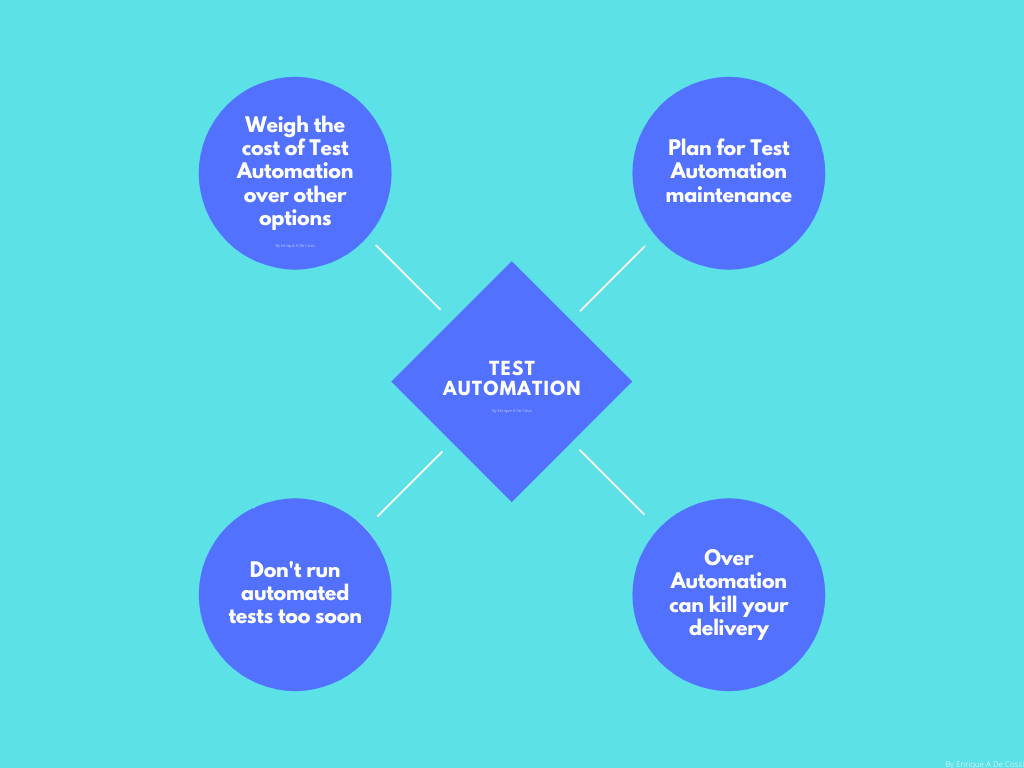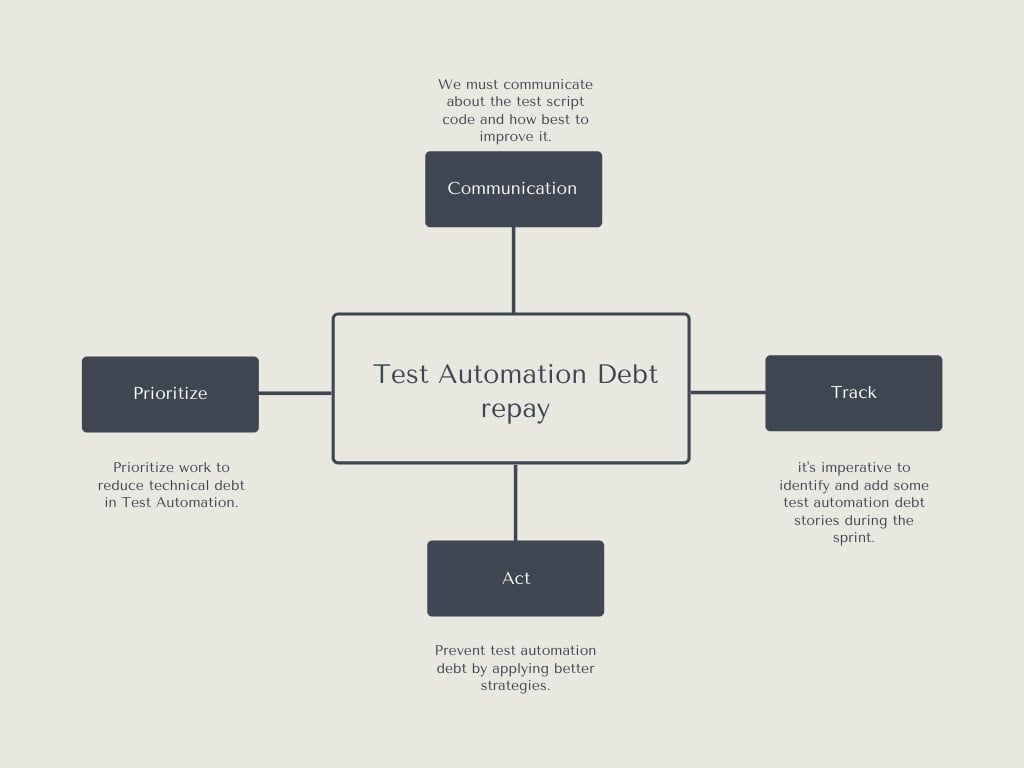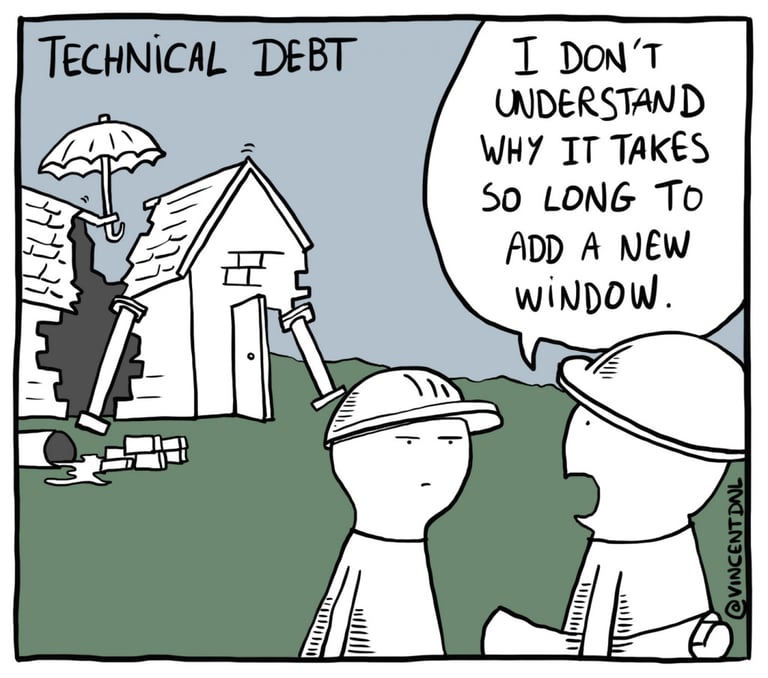Agile Technical Debt: A Practical Guide to Management
Author: Enrique De Coss
Published: October 22, 2021

Table of Contents
Ever feel like you're constantly patching and fixing instead of building something great? You're probably dealing with agile technical debt. It's that nagging feeling when "fix it later" becomes a way of life, especially in agile testing. This isn't just a developer problem. It impacts the entire team, especially QA. Let's talk about the real cost of technical debt—from slowdowns to buggy software—and how to finally get it under control.
“Shipping first-time code is like going into debt. A little debt speeds development so long as it is paid back promptly with a rewrite… The danger occurs when the debt is not repaid. Every minute spent on not-quite-right code counts as interest on that debt. Entire engineering organizations can be brought to a stand-still under the debt load of an unconsolidated implementation, object-oriented or otherwise.”
Ward Cunningham, Computer programmer.
Key Takeaways
- Acknowledge and address technical debt in test automation. Ignoring accumulating issues leads to slower testing, incomplete coverage, and ultimately, a less reliable product. Proactive management improves quality and team velocity.
- Pinpoint the root causes of your team's test automation debt. Common culprits include overly complex test cases, unrealistic estimates, pressure to "automate everything," and a lack of clear coding standards. Identifying these pain points is the first step toward effective management.
- Manage test automation debt strategically, not frantically. Track and prioritize your debt, communicate transparently with your team, and focus on making small, consistent improvements rather than seeking a perfect solution.
What is Technical Debt?
The Agile Alliance defines technical debt as "the implied cost of future refactoring or rework incurred by choosing an easy solution now instead of a better, more time-consuming approach." Think of it like a shortcut: you get there faster initially, but might face roadblocks later. Technical debt isn't limited to just test automation; it impacts the entire software development lifecycle (SDLC), including design, architecture, documentation, and testing. Sometimes, technical debt is a strategic choice for faster delivery. It represents the difference between what was promised and what was delivered, so clear communication between developers and product managers is crucial.
It's important to remember that technical debt isn't just about bugs; it encompasses various code issues like poor architecture, duplicated code, lack of testing, and poor documentation. All these factors contribute to the overall "debt" that needs to be addressed eventually.
Types and Categories of Technical Debt
Intentional vs. Unintentional Debt
Technical debt can be either intentional or unintentional. Intentional debt is a conscious decision made by the team, often to meet a deadline or release a feature quickly. Unintentional debt, on the other hand, is the result of poor coding practices, lack of knowledge, or simply overlooking best practices. Both types of debt need to be managed, but intentional debt is often easier to track and address since it's a documented decision.
Debt by Area (Code, Design, Architecture, Documentation, Testing)
Technical debt can manifest in various areas of software development. Code debt might include messy or inefficient code. Design debt could involve a user interface that's difficult to use. Architecture debt might mean a system that's not scalable. Documentation debt can make it hard for new team members to understand the codebase. And testing debt, often overlooked, can lead to undetected bugs and regressions. Investing in robust testing solutions, like those offered by MuukTest, can help mitigate this risk.
Related Debts: Quality, Process, Feature, UX, Skill
Beyond the core areas, related debts can also impact a project. Quality debt refers to cutting corners on quality assurance. Process debt might involve inefficient workflows. Feature debt can accumulate when features are implemented hastily without considering long-term implications. UX debt results in a poor user experience. Finally, skill debt arises when the team lacks the necessary skills to implement solutions effectively. Addressing skill debt through training and mentorship can improve the overall quality of the codebase and reduce the accumulation of technical debt.
The Four Quadrants of Technical Debt
Martin Fowler's technical debt quadrant provides a helpful framework for categorizing technical debt based on intent and context. This helps teams understand the nature of their debt and prioritize repayment strategies. Understanding these quadrants can help teams make informed decisions about managing technical debt effectively.
Impacts of Technical Debt
Accumulated technical debt can lead to slower development, lower quality software, decreased developer morale, missed deadlines, and hindered agility. Think of it like a snowball rolling downhill – the problems compound over time. The longer you wait to fix bugs, the harder and more expensive they become to address. Technical debt hinders agility by making it difficult to adapt to change and implement new features quickly. This can create a vicious cycle where the team is constantly playing catch-up, impacting their ability to deliver value consistently. Prioritizing testing and addressing technical debt proactively can help teams maintain a healthy and sustainable development pace.
The metaphor compares design choices to accounting: every credit requires a debit. By not correcting faults during development, one takes out a loan on the system and pays for that loan down the road. One may then choose to accept the charge or, if feasible, pay off the debt through corrections. Thus, technical debt in agile projects can be necessary to move forward with the business at hand, much like financial debt.
All the fixes or changes we put off or postpone are considered technical debt. In every case, the bill will come due– with interest. Avoid the confusion related to bugs that need to be fixed. Bugs are almost always associated with the function of the system, not testing tasks.
Strategies for Managing and Reducing Technical Debt
Just like financial debt, technical debt requires careful management. Ignoring it can lead to significant problems down the road. Here are some practical strategies to help you manage and reduce technical debt effectively:
Define and Track Technical Debt
The first step in managing technical debt is to define and acknowledge it. As the Agile Alliance explains, technical debt represents the implied cost of rework caused by choosing an easy solution now instead of a better approach. Create a clear definition of what constitutes technical debt within your team and start tracking it. A simple spreadsheet or a more sophisticated tracking tool can help you visualize and quantify the debt. This allows you to understand the scope of the problem and prioritize effectively.
Prioritize Technical Debt in Sprint Planning
Don't let technical debt fester in the backlog. Treat it like any other feature during sprint planning. Prioritize addressing technical debt alongside new feature development. This ensures that it receives the attention it deserves and prevents it from becoming an insurmountable obstacle. Allocate specific sprints or time slots for tackling technical debt, just as you would for developing new features.
Integrate Testing Throughout the Development Process
Testing shouldn't be an afterthought. Integrate it throughout the development process. As Atlassian suggests, make testing a part of completing a feature, not a separate task. This helps catch potential issues early on, reducing the accumulation of technical debt related to bugs and rework. Continuous testing practices, such as test-driven development (TDD), can be particularly effective.
Automate Bug Fixes with Tests
Every time a bug is discovered, write an automated test to prevent it from recurring. This proactive approach, recommended by Atlassian, not only helps fix the immediate issue but also strengthens your test suite and reduces the likelihood of similar bugs appearing in the future. Automated tests act as a safety net, catching regressions and ensuring that fixes remain in place.
Leverage Tools Like LLMs
Modern tools, such as Large Language Models (LLMs), can be valuable assets in managing technical debt. LLMs can automate tasks like code review and documentation, freeing up developers to focus on addressing core technical debt issues. They can also assist in generating tests and identifying potential problem areas in the codebase. Explore how these tools can augment your existing workflows and improve efficiency.
Make Incremental Improvements
Don't try to tackle all your technical debt at once. Instead, focus on making small, manageable improvements. Incremental changes are less disruptive and allow you to address technical debt gradually without overwhelming the team. Break down large tasks into smaller, more manageable chunks that can be addressed iteratively.
Foster Open Communication
Open communication between developers and product managers is essential for managing technical debt effectively. Ensure that everyone understands the implications of technical debt and is on board with the strategies to address it. Transparency and collaboration are key. Regularly discuss technical debt during team meetings and ensure that it's a shared responsibility.
Improve Software Architecture
Sometimes, the root cause of technical debt lies in the software architecture itself. Improving the architecture can make it easier to fix problems and reduce the accumulation of new technical debt. Consider refactoring or redesigning parts of the system to improve maintainability and scalability. A well-designed architecture can prevent technical debt from accumulating in the first place.
Educate Your Team
Make sure everyone on the team understands the costs and consequences of ignoring technical debt. Education is crucial for fostering a culture of proactive debt management. When everyone is aware of the impact of technical debt, they are more likely to prioritize addressing it. Conduct workshops or training sessions to raise awareness and equip team members with the knowledge and skills to manage technical debt effectively.
Perspectives on Technical Debt
Different teams have different tolerances for technical debt. Agile teams tend to be more sensitive to it than Waterfall teams. There can also be differing views between business and technical staff. Understanding these different perspectives is crucial for effective management. Clearly defining responsibility for technical debt within a Scrum team is essential, ensuring that everyone is accountable for their contribution to the overall debt.
Proactive Technical Debt Management
Proactive management is key. This includes analyzing the severity of technical debt, understanding how different issues are interconnected, and assessing the business value of the code affected by the debt. Prioritize repayment strategically. The Agile Alliance emphasizes this proactive approach to ensure that technical debt is managed effectively and doesn't become a long-term burden. Regularly review and reassess your technical debt to ensure that your strategies are aligned with your business goals.
The development teams working on these applications spend more time dealing with usual issues than developing new functionality, which reduces the delivery of customer value. Technical debt in test automation is understandable, as software development, like testing, is not a linear process. As QA professionals, we should aim to keep technical debt from getting out of hand; this helps us spend more time on new development.
Test Automation Debt
When doing automation testing, we must consider the amount of test debt we have accumulated. Keep in mind that, according to Cunningham’s definition, not fixing issues early on could lead to an unfortunate interest payment; this can mean less test automation coverage, missing validations, or useless test scripts. These consequences can pile up, leading to an accumulation of technical debt in our test automation process.

Common Reasons for Technical Debt in Test Automation
- Test cases are too big or complex to be automated.
- The team did not fully understand the test scenario.
- Lack of estimating skills or consistently unrealistic estimates for test automation stories.
- The team is too pressured to “automate everything.”
- High maintenance cost related to unstructured automated test scripts.
- Test automation is not part of the definition of done (DoD).
- Unexpected things happened during test automation.
- Lack of coding standards for test scripts.
- Lack of understanding from Scrum Masters/Managers about the test automation process.
- Short timeframes for sprints make test automation teams rush and focus only on what must be done to pass the test reports.
Once we identify technical debt in our test automation process, it is essential to track, communicate, and plan accordingly:
- Track – Work with your management and plan to allocate a portion of the future effort to reduce the technical debt; it’s imperative to identify and add some test debt stories during the sprint.
- Prioritize – Prioritize work to reduce technical debt in test automation that will have the most significant impact. Focus on reducing the interest that is accruing on that debt instead of providing the perfect solution.
- Communicate – The longer the test scripts remain in poor condition, the more significant the impact will likely be. We must communicate about the test script code and how best to improve it.

Prevent test automation debt by investing heavily. Plan accordingly and always prioritize your most significant technical debts. It is an undeniable truth that the more you invest in the design and coding standards for test automation, the greater long-term payback you will receive. Shortcuts and sloppy test automation will wind up costing your team more in the immediate term and significantly more over time.
Final Thoughts
Many test automation teams struggle with the need for speed in agile development. Some teams use unstructured record and playback methods or inaccurate testing tools to create and automate tests quickly, resulting in “throw-away automation.” In my experience, we need to rethink our test automation effort to avoid draining resources.
Just because your test automation is working doesn’t mean that it adds value.”
ENRIQUE A DECOSS, SENIOR QA MANAGER AT FICO
Test automation debt is inevitable, and it’s futile to make any attempt to avoid it entirely. Instead, test automation teams should focus on managing it effectively. Proper management and repayment will help your team consistently release quality software products and likely improve productivity throughout several cycles.
Happy Bug Hunting!
Related Articles
- Agile Technical Debt: Taming Test Automation Debt
- Technical Debt in Agile Projects: Impact on Test Automation
- Understanding Test Debt: Causes, Impact, and Solutions
- Why Test Debt Is a Silent Threat to Software Quality
- Understanding and Reducing Technical Debt in Test Automation
Frequently Asked Questions
Is all technical debt bad? Not necessarily. Sometimes technical debt is a strategic trade-off, allowing you to release a feature quickly or meet a critical deadline. The key is to be aware of the debt you're taking on, track it, and have a plan to address it. Unintentional technical debt, stemming from poor practices or lack of knowledge, is the type you really need to watch out for.
How can I convince my team to prioritize addressing technical debt? Frame the conversation around the long-term benefits. Explain how ignoring technical debt leads to slower development speeds, increased bug counts, and difficulty adapting to change. Quantify the impact if possible, showing how much time and resources are being wasted on workarounds or fixing recurring issues. Highlight how addressing technical debt improves code quality, team morale, and ultimately, the product itself.
What are some practical first steps to take in managing technical debt? Start by having an open conversation with your team to define what constitutes technical debt in your specific context. Then, begin tracking it, even if it's just a simple list or spreadsheet. From there, prioritize the most impactful items and incorporate addressing them into your regular sprint planning. Even dedicating a small portion of each sprint to tackling technical debt can make a big difference over time.
What's the biggest mistake teams make when dealing with technical debt? Ignoring it. Often, teams hope it will magically disappear or that they'll have time to deal with it "later." Unfortunately, technical debt, like financial debt, tends to compound over time. The longer you wait to address it, the more costly and complex it becomes to fix. Proactive management is crucial.
What if we simply don't have the time or resources to address our technical debt right now? Even if you're resource-constrained, you can still take small steps. Focus on preventing new technical debt by implementing good coding practices, prioritizing code reviews, and ensuring adequate testing. Even small improvements can prevent the situation from worsening and create a foundation for more comprehensive debt reduction efforts in the future.
Enrique A. Decoss is a Quality Strategist with a focus on automation testing teams. A certified Scrum Master, Tricentis Tosca Certified Automation Architect, and Pythoneer, he focuses on web programming, implementing API testing strategies, as well as different methodologies and frameworks. Enrique is currently at FICO but can be found sharing his knowledge on LinkedIn and Twitter.
Related Posts:

How to Overcome Limitations of Testing in Software Development
Continuous testing is essential to the software development process, but knowing where to stop can be difficult. Testing will never be completed before deadlines and cannot be a comprehensive...

Practical Guide to Software Testing Methodologies
Releasing software with bugs is like serving a five-star meal with a side of food poisoning. It doesn't matter how great the rest of the experience is; one major flaw can ruin everything. That's why...

Testability: 5 Characteristics of Easy-to-Test Software
Understand the 5 key characteristics of testability in software engineering to enhance your testing process and improve software quality.
%20(1).png?width=150&height=69&name=MuukTest-logo---light-background%20(3)%20(1).png)

